There are a couple of ways you could do this.
The first method is a simple loop
df <- data.frame(A = seq(5, 25, 5))
df$b <- 0
for(i in 2:nrow(df)){
df$b[i] <- (1/14)*df$A[i]+(13/14)*df$b[i-1]
}
df
A b
1 5 0.0000000
2 10 0.7142857
3 15 1.7346939
4 20 3.0393586
5 25 4.6079758
This doesn't give the exact values given in the expected answer, but it's close enough that I've assumed you made a transcription mistake. Note that we have to assume that we can take the NA in df$b[1] as being zero or we get NA all the way down.
If you have heaps of data or need to do this a bunch of time the speed could be improved by implementing the code in C++ and calling it from R.
The second method uses the R function sapply
The form you present the problem in

is recursive, which makes it impossible to vectorise, however we can do some maths and find that it is equivalent to

We can then write a function which calculates b_i and use sapply to calculate each element
calc_b <- function(n,A){
(1/14)*sum((13/14)^(n-1:n)*A[1:n])
}
df2 <- data.frame(A = seq(10,25,5))
df2$b <- sapply(seq_along(df2$A), calc_b, df2$A)
df2
A b
1 10 0.7142857
2 15 1.7346939
3 20 3.0393586
4 25 4.6079758
Note: We need to drop the first row (where A = 5) in order for the calculation to perform correctly.

